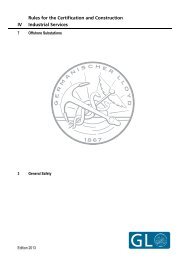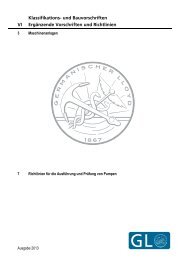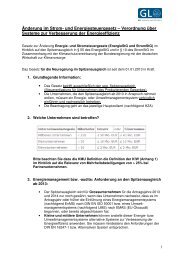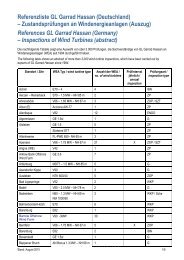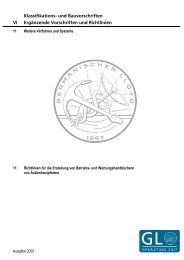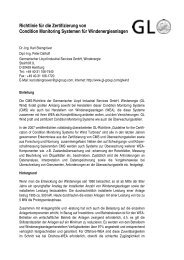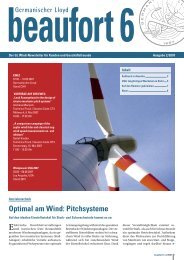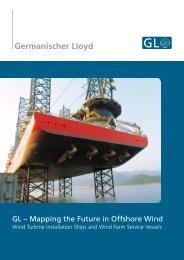energize oil & gas – issue 01-2013 - GL Group
energize oil & gas – issue 01-2013 - GL Group
energize oil & gas – issue 01-2013 - GL Group
Create successful ePaper yourself
Turn your PDF publications into a flip-book with our unique Google optimized e-Paper software.
market unconventional <strong>gas</strong><br />
Shale.<br />
A sedimentary rock<br />
composed of clay<br />
minerals and<br />
quartz, sometimes<br />
carrying trapped<br />
natural <strong>gas</strong>.<br />
said: “The energy industry’s opinion on the future role<br />
of unconventional <strong>gas</strong> has been volatile, as the sector continues<br />
to debate profitability and environmental impacts associated<br />
with its production.”<br />
New US Terminals<br />
There are more than 110 LNG facilities<br />
operating across the US, performing<br />
a range of activities. Some facilities<br />
export natural <strong>gas</strong>, or supply<br />
natural <strong>gas</strong> to the interstate pipeline system<br />
crease since 2000, according to the government agency,<br />
Energy Information Administration (EIA). EIA figures report<br />
that the US has 300 trillion cubic feet (tcf) of <strong>gas</strong> in proven<br />
reserves and potentially ten times that amount in unproven<br />
reserves, much of which is in shale deposits. By comparison,<br />
the US currently consumes about 25 tcf of natural <strong>gas</strong><br />
annually.<br />
Since its 2005 low, US domestic natural<br />
<strong>gas</strong> production has increased by 28 per cent.<br />
Shale <strong>gas</strong> production has accounted for the<br />
bulk of this rise, increasing from 0.39 tcf in<br />
and local distribution companies, while others<br />
are used to store natural <strong>gas</strong> for release during<br />
periods of particularly high demand. There are also<br />
Coalbed methane<br />
2000 to around 8 tcf in 2<strong>01</strong>2 and is expected<br />
to increase significantly in 2<strong>01</strong>3 and beyond.<br />
Asian LNG import prices are averaging<br />
facilities producing LNG for vehicle fuel and industrial<br />
use. US <strong>oil</strong> and <strong>gas</strong> companies are planning<br />
to set up more than 15 new export terminals,<br />
enough to send a full third of current domestic<br />
LNG consumption around the world.<br />
around $15 per thousand cu ft or more, while European<br />
prices are above $11. With US prices under<br />
$5, US companies are keen to export <strong>gas</strong>.<br />
Domestic users are concerned that their costs<br />
will rise as huge volumes are exported, creating<br />
shortages in the domestic market. <strong>GL</strong><br />
There are more than 500,000 <strong>gas</strong> wells<br />
Tight sandstone<br />
currently pumping in the US, a 50 per cent in-<br />
Noble Denton’s Access Manager TM comprises a<br />
Photos: Dariusz Kopestynski, Nightman1965, Shawn Hempel, Teprzem | Dreamstime.com<br />
Unconventional Gas<br />
Most unconventional <strong>gas</strong> production requires the rock to<br />
be fractured (“fracked”) and stimulated to allow <strong>gas</strong> to<br />
escape from the tight rock and flow through the wellbore<br />
to the surface. Complex geology made drilling for unconventional<br />
<strong>gas</strong> uneconomical until recently. These are four<br />
of the most significant sources of unconventional <strong>gas</strong>:<br />
Shale <strong>gas</strong> <strong>–</strong> when natural <strong>gas</strong> is locked in tiny bubble-like<br />
pockets within finely grained, layered sedimentary<br />
rock. Drilling and production advances and<br />
regulatory changes have caused this sector to boom<br />
in the USA. Shale <strong>gas</strong> is encouraged to flow to the<br />
surface after a tool called a perforating gun is lowered<br />
into a newly drilled well and lined up precisely<br />
within the formation where <strong>gas</strong> is calculated to be.<br />
Upon firing, the gun punches small holes into the well<br />
casing, cement and rock. Under high pressure, fracturing<br />
fluid is then pressed out through the small cracks<br />
created in the formation that allow the natural <strong>gas</strong> to<br />
flow from the rock and to the surface.<br />
10 energıze



